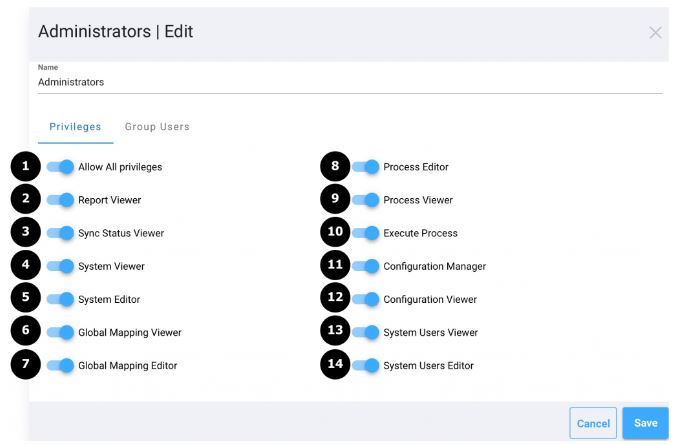Privileges
SyncNow uses a robust role-based access control (RBAC) system to manage permissions and access rights for users within the application. Privileges are assigned to groups, allowing for scalable and secure management of what users can see and do.
Below is a detailed list of SyncNow privileges, describing the specific permissions each privilege grants:
Privilege List
-
Allow All
- Description: Grants complete access to all features and functionalities within SyncNow.
- Permissions: Full administrative rights, including configuration changes, user and group management, and access to all data and settings.
-
Report Viewer
- Description: Provides read-only access to reports and dashboards.
- Permissions: View the Dashboard page to monitor system performance and review generated reports.
-
Status Viewer
- Description: Allows viewing of system statuses and error logs.
- Permissions: Access the Status, Status Entities, Errors, Queue, and Sync Errors pages to monitor processes and troubleshoot issues.
-
System Connector Viewer
- Description: Enables read-only access to system connectors.
- Permissions: View the System Connector page and review integration details and configurations.
-
System Connector Editor
- Description: Provides permissions to manage system connectors.
- Permissions: Add, edit, and delete systems on the Systems page, managing integrations and configurations.
-
Global Mapping Viewer
- Description: Allows viewing of global mappings.
- Permissions: View global mappings on the Global Mappings page and in Process Configuration pages.
-
Global Mapping Editor
- Description: Grants permissions to manage global mappings.
- Permissions: Add, edit, and delete global mappings, ensuring consistency and inheritance across processes.
-
Process Editor
- Description: Provides comprehensive permissions to manage sync and DevOps processes.
- Permissions: Add, edit, and delete sync and DevOps processes on the DevOps Gate and Sync Processes pages.
-
Process Viewer
- Description: Allows read-only access to sync and DevOps processes.
- Permissions: Review sync and DevOps processes without making changes.
-
Execute Process
- Description: Enables the execution of specific processes.
- Permissions: Perform the Sync One Entity action and run sync processes.
-
Service Settings
- Description: Grants permissions to modify service-wide settings.
- Permissions: Edit Service Settings, manage users, groups, privileges, app instances, and licenses.
-
Configuration Manager
- Description: Provides access to review key configuration settings.
- Permissions: View Service Settings, Users, Groups, App Instances pages, and the App Info dialog.
-
System Users Viewer
- Description: Allows viewing of system user mappings.
- Permissions: View the System Users Mapping page to see how users are mapped and managed.
-
System Users Editor
- Description: Grants permissions to manage system user mappings.
- Permissions: Add, edit, and delete system user mappings on the System Users Mapping page.
Tip:
Assign privileges to groups rather than individual users for easier management and scalability. Review group memberships and privilege assignments regularly to maintain security and compliance.
